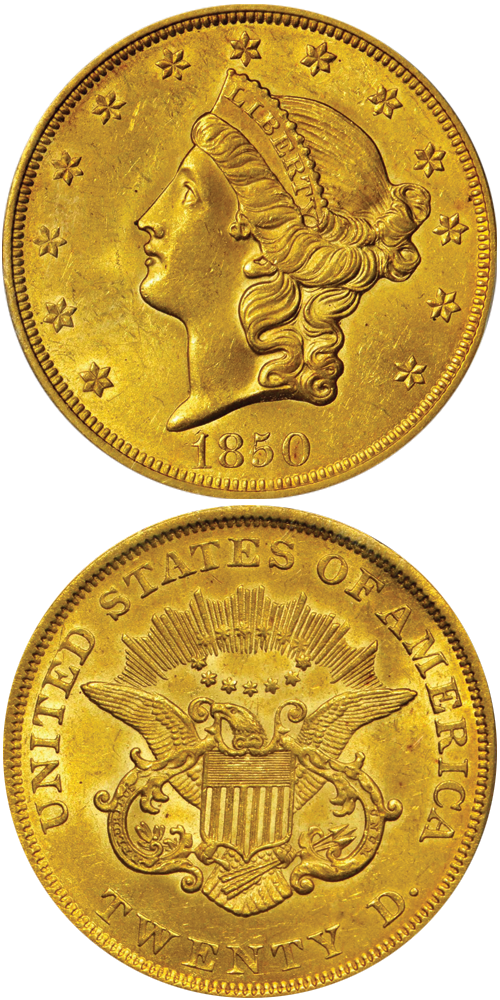1850 Liberty Head Double Eagle
Upon its debut in 1850 the $20 gold double eagle supplanted the $10 gold eagle as the largest regular issue denomination produced by the United States Mint. The double eagle came about as a result of the California Gold Rush, that had been touched off by James Wilson Marshall's discovery of gold in the American River on January 24, 1848. The federal government soon realized that a large denomination coin would serve as a convenient storehouse for the vast quantities of precious metal that were soon flowing east. Authorized by the Act of March 3, 1849, the double eagle fulfilled this role. In American history up to and including 1933, over 75% of the gold used for coinage was made into double eagles.
The 1850 $20 double eagle minted in Philadelphia is the first year of issue and as such, is generally in high demand. The design is nearly identical to the 1849 pattern coin. Usually very well struck, the 1850 typically has frosty or partially prooflike surfaces. In circulated grades up through Extremely Fine, examples are readily available, becoming considerably scarce in Choice AU condition. Mint State pieces, however, are rare, with fewer than a dozen Choice examples known. Just two Gems exist, one of which is in the collection of the American Numismatic Society. Possibly two or three proof specimens were struck, with one confirmed example in the collection of the Bibliothèque Nationale de France in Paris.
The 1850 is the first regular issue double eagle from the Philadelphia Mint. (The unique Proof 1849 in the National Numismatic Collections at the Smithsonian Institution is a pattern.) This denomination, the highest that the United States Mint has ever produced for circulation, was authorized by the Act of March 3, 1849, to serve as a storehouse and convenient medium of exchange for the vast quantities of gold discovered and mined during the California Gold Rush. Indeed, during the earliest years of the double eagle series unprecedented quantities of gold were shipped from California to the eastern United States to be minted into coins at the Philadelphia and, to a lesser extent, New Orleans mints.
Using the Liberty Head design by Chief Engraver James Barton Longacre, the Philadelphia Mint produced 1,170,261 circulation strike double eagles in 1850. This issue saw extensive commercial use with worn survivors in grades such as VF and EF readily available in numismatic circles. Persistent buyers will usually be able to locate an attractive AU without too much difficulty, but Mint State survivors are rare and seldom encountered in any given year of market activity. There was little, if any, contemporary interest in saving high grade examples of this first year issue, and what few Uncirculated coins have survived appear to have done so as a matter of chance. Only a few dozen Mint State examples are believed extant, most of which grade MS-60, MS-61 or MS-62.
The example to the left was sold by Stack's Bowers Galleries in March 2018 as part of the Vanderbilt Collection of U.S. Coins, where it realized $52,800.






